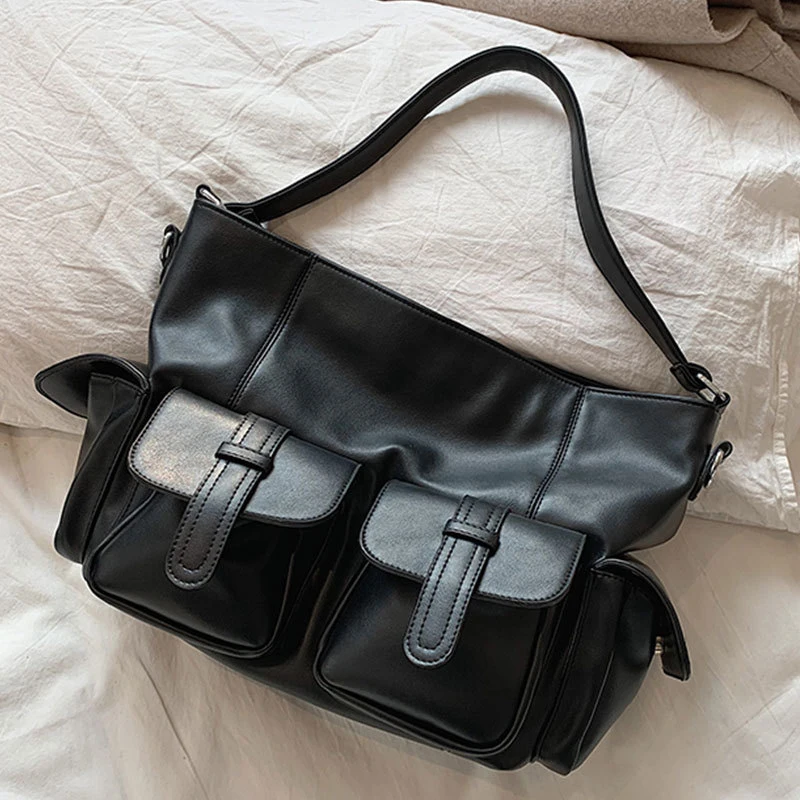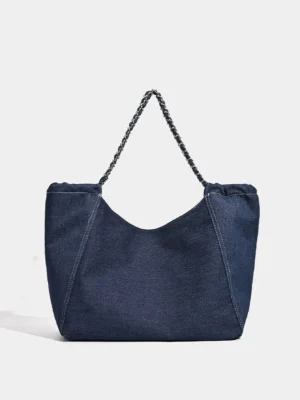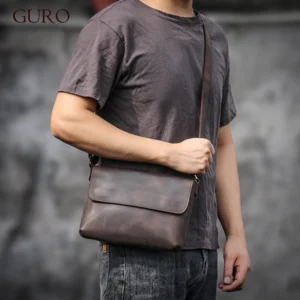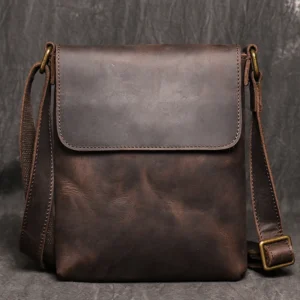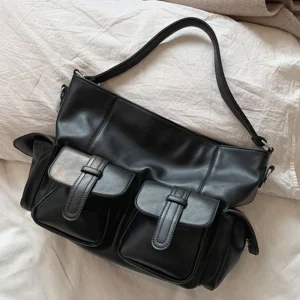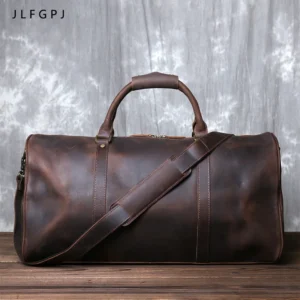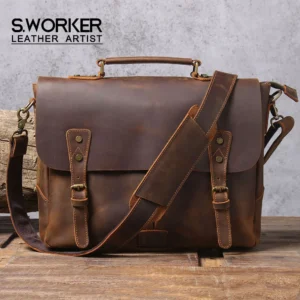Why Messenger Bags Excel for Everyday Carry
Messenger bags have surged in popularity in recent years, becoming the go-to choice for professionals, students, and casual users alike. This rise isn’t merely a fashion trend – it represents a shift toward bags that genuinely enhance our daily routines rather than hinder them. What makes these bags so appealing is their perfect balance of professional appearance, convenient access, and remarkable versatility.
Unlike traditional briefcases or bulky backpacks, messenger bags offer a unique combination of benefits that make them ideal companions for your daily adventures:
Quick-access design: Perhaps the most significant advantage of messenger bags is that you can retrieve items without removing the bag from your body. A simple swing to the front gives you immediate access to your essentials.
Style versatility: Few bag styles transition as seamlessly between professional boardrooms and casual coffee shops. The right messenger bag complements both tailored suits and casual weekend attire.
Ergonomic carrying position: When properly adjusted, messenger bags distribute weight across your body rather than concentrating it on a single shoulder. Studies show this crossbody position can reduce the strain associated with traditional shoulder bags.
Scenario adaptability: From morning commutes to evening networking events, messenger bags adapt to the changing demands of your day without requiring you to switch bags.
Enhanced durability: The design of messenger bags, particularly their reinforced straps and structured bottoms, enables them to withstand the rigors of daily use better than many alternatives.
Superior organization: The typical compartment layout of messenger bags allows for more intuitive organization than the deep caverns of backpacks or limited sections of briefcases.
Industry surveys indicate that messenger bag adoption has increased by over 30% in professional settings in recent years, with many citing the perfect blend of functionality and professional appearance as their primary motivation.
The versatility of leather messenger bags makes them particularly valuable for those who need a bag that works as hard as they do. As we’ll explore throughout this guide, understanding how to maximize your messenger bag’s potential can transform your daily carrying experience.
The growing appeal of messenger bag versatility speaks to how modern professionals prioritize both form and function. Let’s explore the specific scenarios where these bags truly shine.
Everyday Scenarios Where Messenger Bags Shine
Messenger bags prove their worth in a variety of daily situations, adapting to your needs throughout the day. Here are six common scenarios where messenger bags demonstrate their exceptional utility:
1. Navigating Public Transportation
During crowded commutes, messenger bags excel by staying close to your body while allowing quick access to transit cards or phones. Their slim profile helps you navigate packed subway cars or buses without the bulkiness of backpacks that can bump other passengers.
2. Professional Office Environments
In business settings, messenger bags strike the perfect balance between functionality and professional appearance. They comfortably carry laptops, documents, and tech accessories while maintaining a sleek look that complements business attire. The ability to quickly access items during meetings without disruption is particularly valuable.
3. Academic Settings
Students benefit from messenger bags’ ability to organize textbooks, notebooks, and tech devices in accessible compartments. The quick-access design proves particularly useful when moving between classes and needing to retrieve specific materials quickly.
4. Shopping and Casual Outings
For errands and casual outings, messenger bags provide hands-free convenience while carrying everyday essentials. They can easily accommodate purchases, water bottles, and personal items without becoming unwieldy.
5. Weekend Getaways
As compact travel companions, messenger bags can efficiently organize travel documents, electronic devices, and personal items for short trips. Their accessibility makes them perfect for retrieving items while in transit.
6. Active Urban Transportation
Cyclists and active commuters appreciate the stability of commuting leather messenger bags which stay securely positioned against the body during movement. Unlike backpacks which can shift during active commuting, properly adjusted messenger bags remain stable.
Each scenario highlights how messenger bags adapt to different carrying needs while maintaining consistent advantages in accessibility, organization, and style. The key is selecting a bag with features that align with your specific daily activities.
Essential Features That Make a Messenger Bag Perfect for Daily Use
Understanding the anatomy of a well-designed messenger bag helps you make informed choices about which features matter most for your daily needs. The difference between an adequate bag and an exceptional one often comes down to these key elements:
Strap Design and Padding
A properly designed messenger bag strap distributes weight evenly across your body. Look for wide straps (at least 2 inches) with substantial padding at the shoulder point. The best bags feature adjustable straps that allow positioning for different body types and carrying preferences. Some premium bags include stabilizer straps that prevent shifting during active movement.
Material Quality and Selection
The material of your messenger bag dramatically impacts its performance, appearance, and longevity:
– Full-grain leather offers exceptional durability and develops a rich patina over time
– Waxed canvas provides water resistance with a casual aesthetic
– Ballistic nylon delivers technical performance with lightweight properties
– Specialized materials like water-resistant polyester blend functionality with modern styling
Compartment Layout and Organization
The internal architecture of the bag determines how efficiently you can organize and access your items. Effective designs include:
– A padded laptop sleeve positioned against the back panel for weight distribution
– Multiple internal dividers that prevent items from shifting
– Pen holders and small-item pockets that keep accessories organized
– Document sleeves that prevent paper from wrinkling
Closure Mechanisms
The balance between security and accessibility often comes down to closure design:
– Traditional buckles offer security and classic styling but slower access
– Magnetic closures provide quick access with moderate security
– Zippered compartments offer maximum security for valuables
– Hook-and-loop fasteners combine speed with adjustable capacity
Size Proportions
The dimensions of your messenger bag should align with your daily carry requirements:
– Compact bags (11-13 inches wide) work well for minimalist everyday carry
– Medium bags (14-16 inches) accommodate laptops and additional daily essentials
– Larger models (17+ inches) suit those who carry multiple devices or extra clothing
The everyday messenger bag functionality ultimately depends on how these features work together to meet your specific needs. When evaluating bags, consider how you’ll use the bag most frequently and prioritize features accordingly.
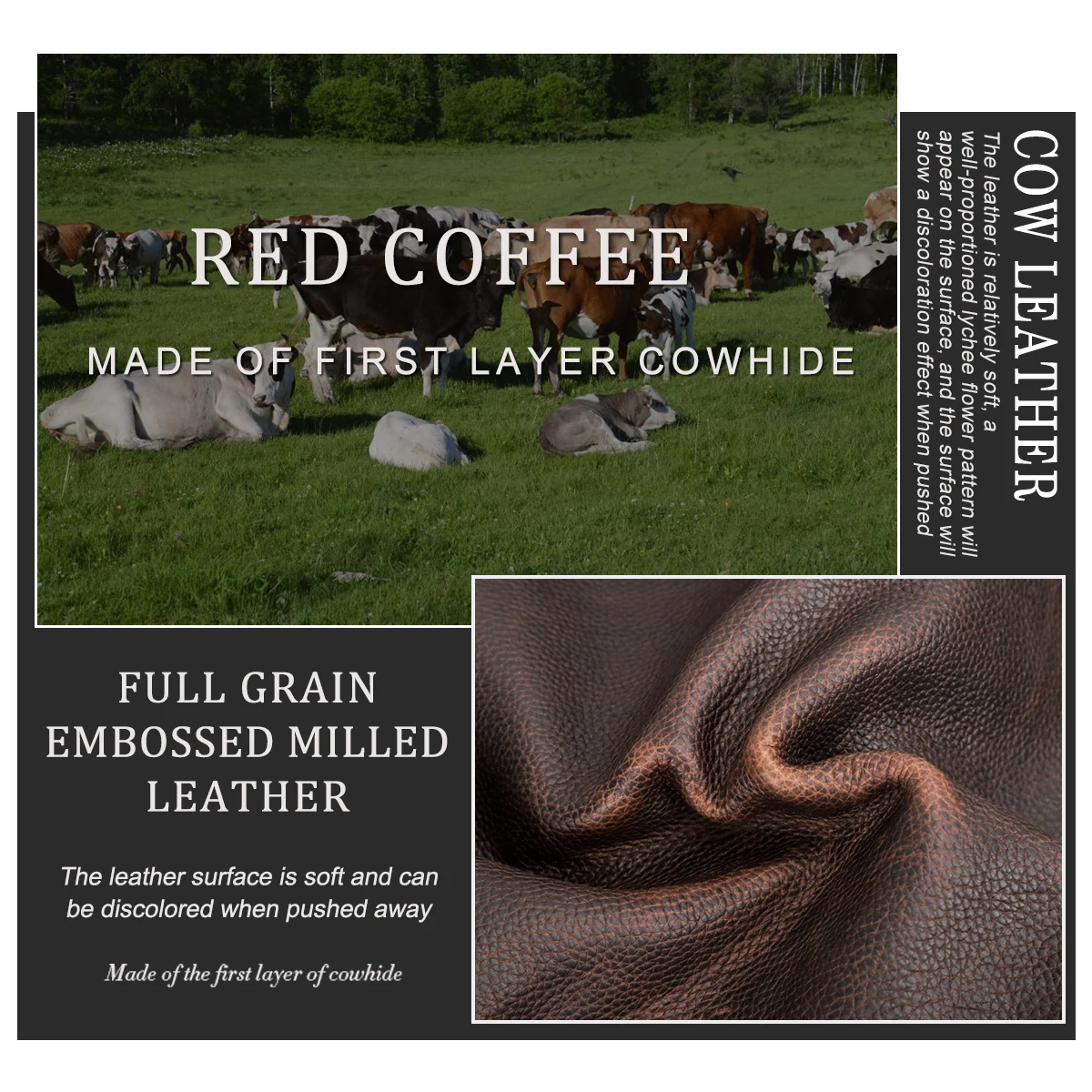
Material Matters: Choosing the Right Messenger Bag Fabric
The material of your messenger bag affects everything from its appearance and durability to maintenance requirements and how it ages. Here’s a detailed comparison of common messenger bag materials to help you make an informed choice:
| Material | Professional Appeal | Durability | Weather Resistance | Weight | Maintenance | Aging Characteristics |
|---|---|---|---|---|---|---|
| Full-Grain Leather | Excellent | Very High | Moderate (improves with treatment) | Heavy | Regular conditioning | Develops rich patina, improves with age |
| Top-Grain Leather | High | High | Moderate | Medium-Heavy | Regular conditioning | Consistent appearance, minimal patina |
| Waxed Canvas | Casual-Professional | Very High | Excellent | Medium | Occasional rewaxing | Develops character with wear |
| Ballistic Nylon | Modern-Technical | Extremely High | Very Good | Light | Minimal cleaning | Maintains consistent appearance |
| Polyester | Casual | Moderate | Variable (depends on treatment) | Very Light | Simple cleaning | May show wear over time |
Leather Options
Premium full-grain messenger bags represent the pinnacle of professional appearance and longevity. This material uses the top layer of the hide with all natural grain intact, resulting in superior strength and a distinctive appearance that improves with age. The natural variations in the leather create a unique bag that develops character through years of use. However, leather requires maintenance through occasional conditioning and offers moderate water resistance that improves with proper treatment.
Canvas and Hybrid Materials
Canvas leather messenger bags combine the casual durability of waxed canvas with leather trim for a balance of ruggedness and refinement. Waxed canvas offers excellent water resistance and develops unique wear patterns that tell the story of your daily journeys. These bags tend to be lighter than all-leather options while maintaining substantial durability. Canvas requires occasional rewaxing to maintain water resistance.
Modern Synthetic Materials
Technical synthetic materials like ballistic nylon and ripstop polyester offer outstanding performance metrics. These ultra-lightweight options provide excellent tear resistance and often feature built-in water resistance. They require minimal maintenance and maintain consistent appearance over time. The trade-off comes in the form of a more casual or technical appearance that may not suit formal professional environments.
When selecting your material, consider not just your aesthetic preference but also your typical usage environment, maintenance willingness, and how you want the bag to evolve over time.
Smart Storage: Understanding Compartment Design
The internal organization of your messenger bag determines how efficiently you can store and access your daily essentials. A well-designed compartment layout transforms a simple bag into a productivity tool that enhances your daily routine.
Laptop Compartment
The gold standard in laptop protection features:
– Padded walls with at least ¼-inch foam protection
– Suspended design that prevents the laptop from contacting the bottom of the bag
– Secure closure that prevents the device from sliding out
– Appropriate sizing (most professional bags accommodate 13-15” laptops)
For optimal protection, your laptop compartment should position the device against your back when carrying, distributing weight more effectively and protecting the device from external impacts.
Main Compartment Design
This central storage area should feature:
– Sufficient volume for books, folders, or clothing
– Structured sides that prevent collapse when partially filled
– Light-colored lining that improves visibility of contents
– Reinforced bottom panel that maintains shape and provides protection
Internal Organization Panel
Effective organization systems include:
– Multiple pocket sizes for various accessories
– Pen holders positioned for easy access
– Secured zippered pockets for valuable small items
– Card slots or small pockets for business cards and transit passes
Quick-Access External Pockets
These crucial compartments should offer:
– One-handed operation for items needed on the go
– Weather-protected closures for sensitive items
– Strategic positioning for balanced weight distribution
– Sufficient depth to secure items without bulging
Specialized Storage Features
Premium messenger bags often include:
– Water bottle pockets with elastic retention
– Padded tablet sleeves separate from laptop compartments
– Discrete security pockets positioned against your body
– Key leashes that prevent keys from getting lost in the bottom of the bag
Thoughtful messenger bag essentials organization dramatically reduces the time spent searching for items and protects your valuable gear. When evaluating bags, consider how the compartment design aligns with your specific carrying needs.
For those who regularly transport laptops, professional laptop messenger bags offer specialized features focused on device protection and business organization.
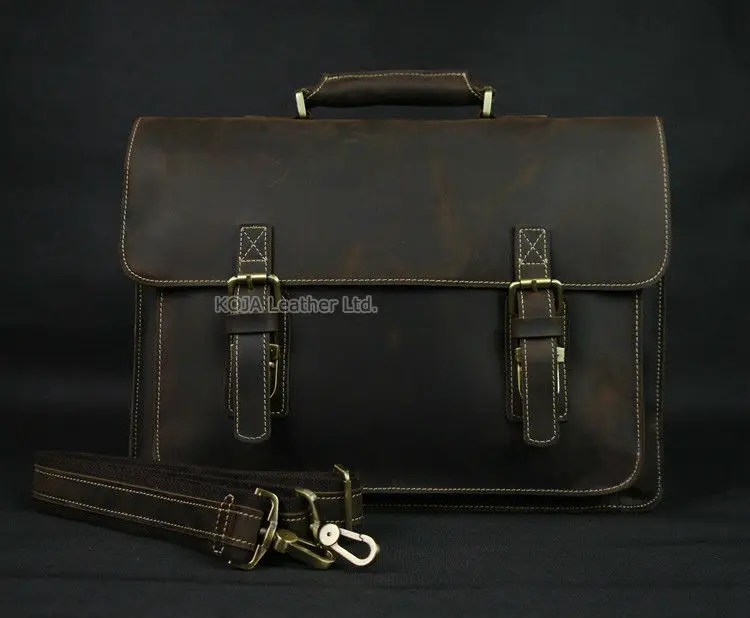
Comparing Messenger Bags to Alternative Daily Carriers
Understanding how messenger bags compare to other popular bag styles helps clarify which option best suits your specific needs. Each bag type offers distinct advantages for different carrying situations and professional contexts.
Messenger Bags vs. Backpacks
| Aspect | Messenger Bags | Backpacks |
|---|---|---|
| Professional Appearance | Medium to High (material dependent) | Low to Medium (design dependent) |
| Item Accessibility | Excellent (without removing bag) | Limited (requires removal) |
| Weight Distribution | Asymmetrical across body | Symmetrical across shoulders |
| Capacity | Moderate | High |
| Formal Setting Appropriateness | Good to Excellent | Poor to Fair |
| Active Movement Compatibility | Good (with stabilizer strap) | Excellent |
Messenger bags excel in professional environments where appearance matters and you need frequent access to contents. Backpacks offer superior carrying comfort for heavy loads over extended periods but sacrifice quick access and formal appearance.
Messenger Bags vs. Briefcases
| Aspect | Messenger Bags | Briefcases |
|---|---|---|
| Professional Appearance | Good to Excellent | Excellent |
| Hands-Free Capability | Excellent | Poor |
| Organization | Very Good | Excellent |
| Capacity Flexibility | Good | Limited |
| Formal Setting Appropriateness | Very Good | Excellent |
| Comfort for Extended Carrying | Good | Poor |
Traditional briefcases maintain a slight edge in formal professional settings but lack the hands-free convenience and carrying comfort that messenger bags offer. Modern professional messenger bags bridge this gap with refined designs that work in all but the most formal business environments.
Messenger Bags vs. Tote Bags
| Aspect | Messenger Bags | Totes |
|---|---|---|
| Professional Appearance | Good to Excellent | Fair to Good |
| Security | Excellent | Poor to Fair |
| Organization | Very Good | Limited |
| Hands-Free Capability | Excellent | Poor |
| Formal Setting Appropriateness | Very Good | Variable |
| Quick Access to Contents | Very Good | Excellent |
Tote bags offer excellent simplicity and rapid access but sacrifice organization and security. They lack the sophisticated organization systems and security features that make messenger bags suitable for professional use.
Fashion consultants and ergonomic specialists often recommend messenger bags as the optimal middle ground for professionals who need to balance appearance with functionality. As career coach Maria Johnson notes, “The way you carry your professional items affects both your comfort and the impression you make. A quality messenger bag strikes the perfect balance between practical function and polished image.”
When weighing different options, consider how the large vs slim briefcase guide principles apply to your specific carrying needs and professional environment.
When to Choose a Messenger Bag (And When Not To)
Messenger bags shine in specific scenarios but aren’t universally ideal for every situation. Understanding when they excel—and when alternatives might serve you better—helps you make the right choice for your needs.
Ideal Scenarios for Messenger Bags:
Urban Commuting: When navigating public transportation, messenger bags allow you to stand securely with your bag positioned at your side or front for theft prevention.
Professional Settings with Movement: For professionals who alternate between meetings, client visits, and desk work, messenger bags provide quick access without the formality break of removing a backpack.
Light to Medium Loads: When carrying a laptop, tablet, documents, and daily essentials weighing under 15 pounds total, messenger bags distribute weight effectively.
Mixed-Use Days: When your day includes both professional and casual elements, messenger bags transition seamlessly between contexts.
Cyclists and Active Commuters: The stable crossbody position makes messenger bags ideal for those who bike or walk substantial distances.
When Alternative Bag Styles May Be Preferable:
Heavy Loads: When regularly carrying more than 15 pounds of equipment, backpacks offer better weight distribution across both shoulders.
Extremely Formal Environments: In traditional corporate settings with conservative dress codes, classic briefcases may still hold a slight edge in perceived professionalism.
Extended Standing or Walking: If you’ll be on your feet for many hours with your bag, the dual-strap support of backpacks reduces fatigue.
Specialized Activities: Technical activities like photography or specific sports may benefit from purpose-built bags with specialized compartments.
The key is honestly assessing your typical daily requirements and choosing the perfect daily messenger bag that aligns with those needs. Consider factors like your commute style, typical items carried, professional environment, and personal comfort preferences when making your selection.
Mastering Messenger Bag Organization for Maximum Efficiency
A well-organized messenger bag transforms from a simple carrying solution into a mobile command center that enhances your daily productivity. The key lies in intentional organization rather than haphazard packing.
Step 1: Assess Your Daily Essentials
Begin by identifying what you truly need to carry daily versus what can stay at home or the office. Typical professional essentials include:
– Laptop/tablet and associated chargers
– Smartphone and charging cable
– Notebook or planner
– Writing instruments
– Wallet and keys
– Water bottle
– Medications or personal care items
– Business cards
Step 2: Prioritize by Access Frequency
Categorize your items based on how often you need to access them:
– Constant access: phone, transit card, keys
– Frequent access: notebook, pens, water bottle
– Occasional access: laptop charger, business cards
– Rare access: emergency items, seasonal accessories
Step 3: Strategic Placement
Position items according to their access requirements:
– Place frequently accessed items in external pockets or the top of main compartments
– Store your laptop and documents in dedicated padded compartments
– Keep small, easily lost items in zippered security pockets
– Position heavy items closest to your body to improve weight distribution
Step 4: Use Organizational Tools
Enhance your bag’s internal structure with:
– Cable organizers for tech accessories
– Small pouches for loose items like memory cards or medications
– Pen holders or cases
– Folder systems for important documents
Common Organization Mistakes to Avoid:
– Overloading the bag beyond its design capacity
– Placing sharp objects against technology
– Storing liquids without secure containers
– Mixing frequently used items with rarely used ones
– Neglecting to use dedicated compartments for their intended purpose
For professionals dealing with substantial paperwork, learning proper document organization in leather bags can prevent wrinkling and improve retrieval efficiency.
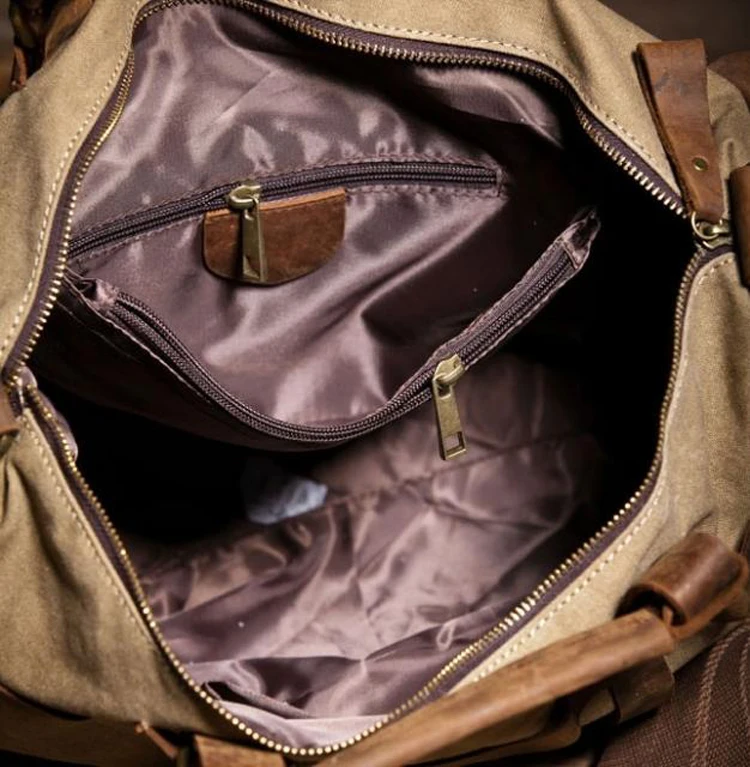
Zone-Based Organization: A System for Daily Efficiency
The zone system provides a structured approach to messenger bag organization that maximizes efficiency and minimizes frustration. By dividing your bag into purpose-specific areas, you’ll always know where to find what you need.
Quick-Access Zone
Location: Front pockets, top of main compartment
Contents:
– Smartphone
– Transit cards and ID
– Frequently used keys
– Earbuds or headphones
– Small notebook or planner
The quick-access zone should feature one-handed operation, allowing you to retrieve items while walking or standing on public transportation. Use small pouches in different colors to easily identify specific items by touch.
Main Working Zone
Location: Central compartment
Contents:
– Laptop or tablet
– Documents for the day
– Notebooks or portfolios
– Current reading materials
– Lunch container (if applicable)
The main zone benefits from dividers or folders that keep items separate and prevent shifting. Consider using a slim laptop sleeve for additional protection even if your bag has a built-in laptop compartment.
Secure Zone
Location: Inner zippered pockets, compartments against your body
Contents:
– Wallet
– Passport or important identification
– Medication
– Expensive electronics (other than primary devices)
– Confidential documents
Items in the secure zone should be protected by multiple closure mechanisms and positioned where they’re difficult for others to access when you’re wearing the bag.
Specialized Zones
Location: Purpose-built external pockets or internal holders
Contents:
– Water bottle (water-resistant pocket)
– Umbrella (quick-access external holder)
– Business cards (dedicated card pocket)
– Pens and small tools (organizational panel)
For maximum efficiency, pair your zone system with color-coded accessories. Small pouches in different colors allow you to instantly identify contents without searching. Cable organizers prevent the dreaded “cable salad” that wastes precious minutes of your day.
Studies suggest that a well-organized bag can save professionals up to 15 minutes daily that would otherwise be spent searching for items. For recommendations on bags with excellent organizational features, explore our collection of best messenger bags for daily use.
Canvas & Leather Messenger Bag, Leather Commuter Tote
$80.41 Select options This product has multiple variants. The options may be chosen on the product pageCrazy Horse Leather Satchel, Men's Leather Satchel, Men's Professional Leather Messenger, Vintage Style Messenger Bag
$132.70 Select options This product has multiple variants. The options may be chosen on the product pageBrown Leather Messenger Bag, Men's Leather Satchel, Men's Professional Leather Messenger
$118.87 Select options This product has multiple variants. The options may be chosen on the product pageBlack Leather Messenger Bag, Black Leather Work Tote, Faux Leather Work Tote
$101.88 Select options This product has multiple variants. The options may be chosen on the product pageCrazy Horse Leather Satchel, Full Grain Messenger Bag, Men's Leather Satchel
$430.41 Select options This product has multiple variants. The options may be chosen on the product pageCrazy Horse Leather Satchel, Men's Classic Leather Briefcase, Professional Laptop Messenger
Price range: $460.43 through $536.25 Select options This product has multiple variants. The options may be chosen on the product page
Selecting Your Ideal Messenger Bag: A Practical Buying Guide
With countless options available, finding the perfect messenger bag requires a methodical approach focused on your specific needs. This framework will help you identify the features that matter most for your daily use.
1. Usage Pattern Assessment
Begin by honestly evaluating how you’ll primarily use the bag:
– Daily professional commute
– Client meetings and presentations
– Academic environments
– Casual everyday carry
– Frequent travel
Your primary use case should drive decisions about formality, durability requirements, and organizational features.
2. Critical Feature Prioritization
Based on your usage pattern, prioritize the features that matter most:
– Professional appearance: Premium materials, refined design
– Organization: Multiple specialized compartments
– Durability: Reinforced construction, premium materials
– Comfort: Padded straps, ergonomic design
– Weather protection: Waterproof materials or included cover
– Security: Hidden compartments, secure closures
Remember that no bag excels in all categories—the goal is finding the right balance for your specific needs.
3. Size Selection
Match the bag dimensions to your typical carry load:
– Compact (9-12”): Tablet, small essentials, minimal documents
– Medium (13-15”): Standard laptop, notebook, daily essentials
– Large (16”+): Large laptop, extensive documents, extra clothing
Consider both the dimensional requirements of your largest item (typically a laptop) and the total volume needed for all daily items.
4. Material Selection
Choose materials based on your lifestyle and preferences:
– Full-grain leather: Professional environments, long-term investment
– Waxed canvas: Rugged durability, weather resistance, casual-professional
– Technical synthetics: Maximum durability, minimal weight, casual settings
The material significantly impacts both appearance and performance—consider your work environment’s formality and your willingness to perform maintenance.
Investment Considerations
Quality messenger bags typically fall into three price tiers:
– Entry-level ($50-100): Basic functionality, limited durability
– Mid-range ($100-200): Good quality, balanced features
– Premium ($200+): Exceptional materials, craftsmanship, and longevity
When evaluating cost, consider the bag’s expected lifespan. Premium bags often cost less per year of use than repeatedly replacing lower-quality options.
For those seeking comfort in daily carry, lightweight leather messenger options offer an excellent balance of professional appearance and reduced weight. For versatile professional settings, black leather messenger bags provide timeless appeal that complements any outfit.
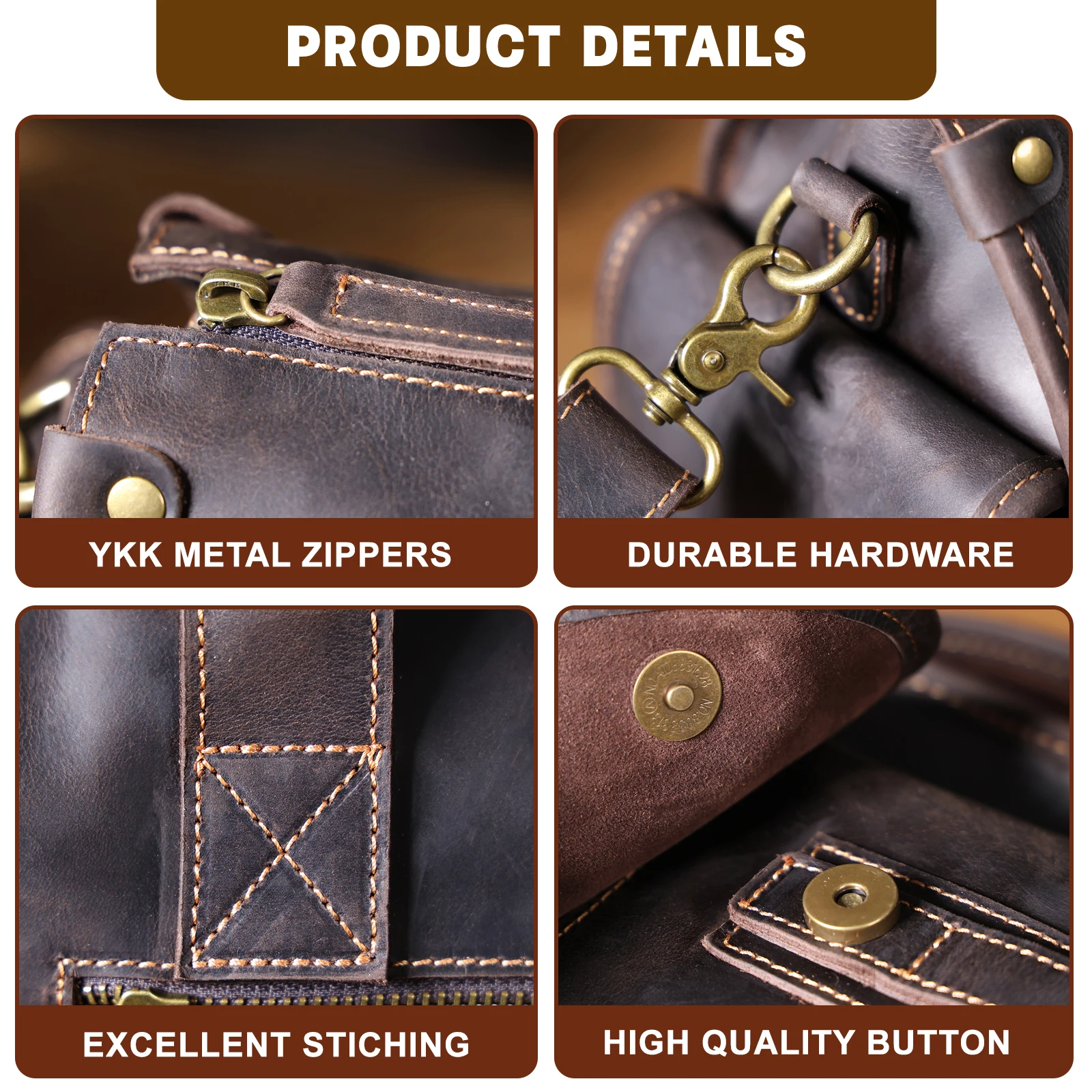
Matching Bag Features to Your Daily Requirements
This decision matrix helps match specific messenger bag features to your individual needs, ensuring you select a bag with capabilities that align with your daily requirements.
| Daily Requirement | Must-Have Features | Nice-to-Have Features | Features to Avoid |
|---|---|---|---|
| Laptop Protection | Padded compartment sized for your device | Suspended design, water-resistant lining | Loose, unpadded compartments |
| Frequent Rain Exposure | Water-resistant material or waxed finish | Sealed seams, protective flap design | Untreated leather without protection |
| Public Transit Commute | Security pockets, crossbody stabilizer | RFID protection, quick-access transit card pocket | Noisy closure mechanisms, bulky design |
| Formal Business Settings | Premium materials, refined hardware | Briefcase handle option, business card storage | Excessive external pockets, casual styling |
| Cycling/Active Commute | Stabilizer strap, reflective details | Helmet attachment, ventilated back panel | Loose straps that could catch, shifting weight |
| Extensive Technology | Multiple padded compartments, cable organization | Power bank pocket, cord pass-throughs | Magnetic closures near hard drives |
| Frequent Travel | TSA-compatible laptop access, luggage strap | RFID blocking, hidden security pocket | Complicated closures, excess weight |
Device Protection Considerations
For laptop carriers, the protection system should match your device dimensions precisely. A bag designed for a 15” laptop will allow a 13” device to shift during movement, potentially causing damage. Similarly, trying to fit a 15” laptop into a 13” compartment stresses the bag’s structure and closure systems.
Weather Resistance Realities
Your local climate should influence material selection. In rainy regions, look for:
– Naturally water-resistant materials like waxed canvas
– Protected zippers with flap coverings
– Roll-top designs that prevent water ingress
– Sealed seams that prevent moisture penetration
Professional Image Factors
In conservative industries, subtle styling cues matter. Consider:
– Hardware finish (brass vs. nickel vs. matte black)
– Strap width and prominence
– Logo visibility and placement
– Color selection (traditional brown/black vs. contemporary colors)
For those seeking bags with exceptional longevity, exploring ultimate guide to durable messenger bags can help identify construction features that enhance long-term performance.
Integrating Your Messenger Bag into Your Daily Style
A messenger bag does more than carry your essentials—it’s a visible accessory that contributes to your overall image. Here’s how to ensure your bag enhances rather than detracts from your personal style.
Business Formal Integration
In formal professional environments:
– Choose structured bags with clean lines and minimal external hardware
– Opt for premium leather in traditional colors (black, dark brown, oxblood)
– Select a size proportional to your frame—oversized bags can undermine a formal look
– Coordinate leather tones with your shoes and belt for a cohesive appearance
– Consider a bag with a briefcase handle option for client meetings
Business Casual Coordination
For versatile office environments:
– Waxed canvas with leather trim offers a perfect balance of professionalism and personality
– Navy, olive, and burgundy provide alternatives to traditional black and brown
– Slightly more relaxed structures work well while maintaining organization
– Consider how the bag pairs with your typical footwear and outerwear
Smart Casual and Weekend Styling
For off-duty moments:
– Embrace more expressive colors and textures
– Consider vintage-inspired designs with character
– Allow for a slightly more relaxed carrying position
– Pair with complementary casual accessories
Carrying Position Considerations
The way you wear your messenger bag affects both comfort and appearance:
– For taller individuals, position the bag at hip level or slightly higher
– For shorter frames, a higher position (mid-back) often looks more proportional
– When wearing tailored clothing, adjust the bag to minimize wrinkling
– With outerwear, decide whether the bag works better under or over your coat based on access needs
Seasonal Adjustments
Adapt your messenger bag approach across seasons:
– Summer: Consider lighter colors and materials, slightly higher carrying position
– Winter: Adjust strap length to accommodate bulkier clothing, consider weather protection
For more detailed guidance on creating a cohesive look, explore our guide on styling leather messenger bags. For timeless appeal that works across multiple environments, consider our selection of vintage-style messenger bags.
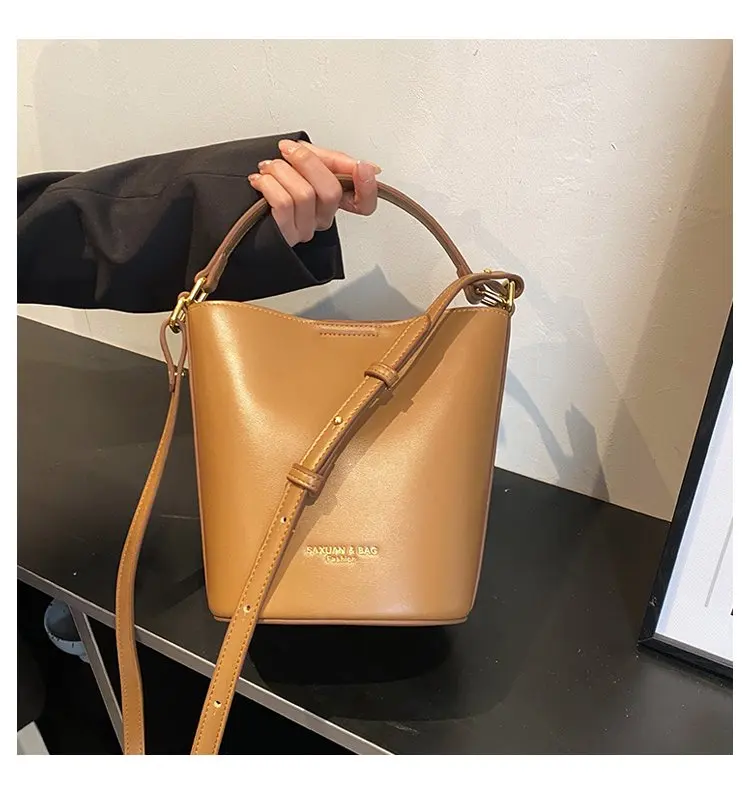
Maintaining Your Messenger Bag for Years of Everyday Use
A quality messenger bag is an investment that can last for many years with proper care. Following material-specific maintenance routines ensures your bag ages beautifully rather than simply wearing out.
Leather Care Essentials
For full-grain and top-grain leather bags:
– Clean regularly with a slightly damp cloth to remove dust and debris
– Apply leather conditioner every 3-6 months depending on usage and climate
– Use leather protector spray to guard against water damage and staining
– Address scratches with appropriate leather balm that matches your bag’s finish
– Store leather bags stuffed with paper when not in use to maintain shape
– Keep leather away from direct sunlight and heat sources when storing
Canvas Maintenance
For waxed and unwaxed canvas:
– Spot clean with mild soap and cold water as needed
– Re-wax canvas annually or when water no longer beads on the surface
– Never machine wash or dry canvas bags with leather elements
– Use soft brushes rather than abrasive materials for cleaning
– Allow to air dry completely if the bag becomes wet
Synthetic Material Care
For nylon and polyester bags:
– Clean with mild soap and warm water as needed
– Use specialized technical fabric cleaners for stubborn stains
– Ensure complete drying before storage to prevent mildew
– Avoid harsh chemicals that can break down water-resistant treatments
– Re-apply water-resistant spray treatments annually
Hardware Maintenance
To keep closures and fittings functioning properly:
– Inspect hardware regularly for signs of wear or loosening
– Apply appropriate metal polish to brass or nickel fittings
– Lubricate zippers occasionally with zipper-specific lubricant
– Tighten any loose screws or rivets promptly
– Clean closure mechanisms to remove dust and debris that can affect function
Stress Point Protection
Pay special attention to high-wear areas:
– Reinforce the bottom corners if they begin to show wear
– Check strap attachments frequently for signs of stress
– Monitor the bag’s bottom for developing thin spots
– Inspect internal dividers and pockets for tearing
Proper care dramatically extends the lifespan of quality bags. Many of Poise Porter’s best leather messenger bags for daily use include care instructions specific to their construction and materials.
Supplementary Content: Addressing Common Questions About Everyday Messenger Bag Use
How can I prevent shoulder pain when using a messenger bag daily?
Shoulder discomfort usually results from improper carrying technique rather than inherent messenger bag design. Adjust your bag to sit high on your back with the strap crossing your chest diagonally. The bag should rest against the lower back, not swinging freely at your side. For heavier loads, use bags with wider straps (at least 2 inches) and consider padding accessories for the shoulder area. Regularly switch sides to distribute pressure evenly, and avoid overloading your bag beyond necessary items.
What’s the ideal messenger bag size for everyday professional use?
For most professionals, a medium-sized messenger bag (approximately 15 inches wide, 11 inches tall, and 4-5 inches deep) provides optimal capacity without becoming unwieldy. This size comfortably accommodates a 13-15 inch laptop, necessary documents, and daily essentials. If you rarely carry a laptop, a smaller 12-13 inch width may be sufficient. Conversely, those who transport larger items might require a 16-17 inch bag. The key is selecting a size proportional to both your frame and your typical carrying needs.
Are messenger bags appropriate in formal business settings?
Premium leather messenger bags with refined styling are entirely appropriate in most formal business environments. Look for bags with clean lines, minimal external hardware, and structured design that maintains shape even when not full. Traditional colors like black, dark brown, or oxblood project the most formal appearance. Some men’s professional leather messenger bags include a top handle that allows them to be carried briefcase-style in particularly formal meetings.
How do messenger bags compare to satchels for daily use?
While the terms are sometimes used interchangeably, traditional satchels typically feature a shorter strap length, more structured design, and slightly more formal appearance than messenger bags. Messenger bags generally offer more practical features for daily use, including padded laptop compartments, water bottle holders, and organization panels. Satchels might hold a slight edge in very traditional formal environments, while messenger bags excel in versatility across different daily scenarios and typically offer superior comfort for extended carrying.
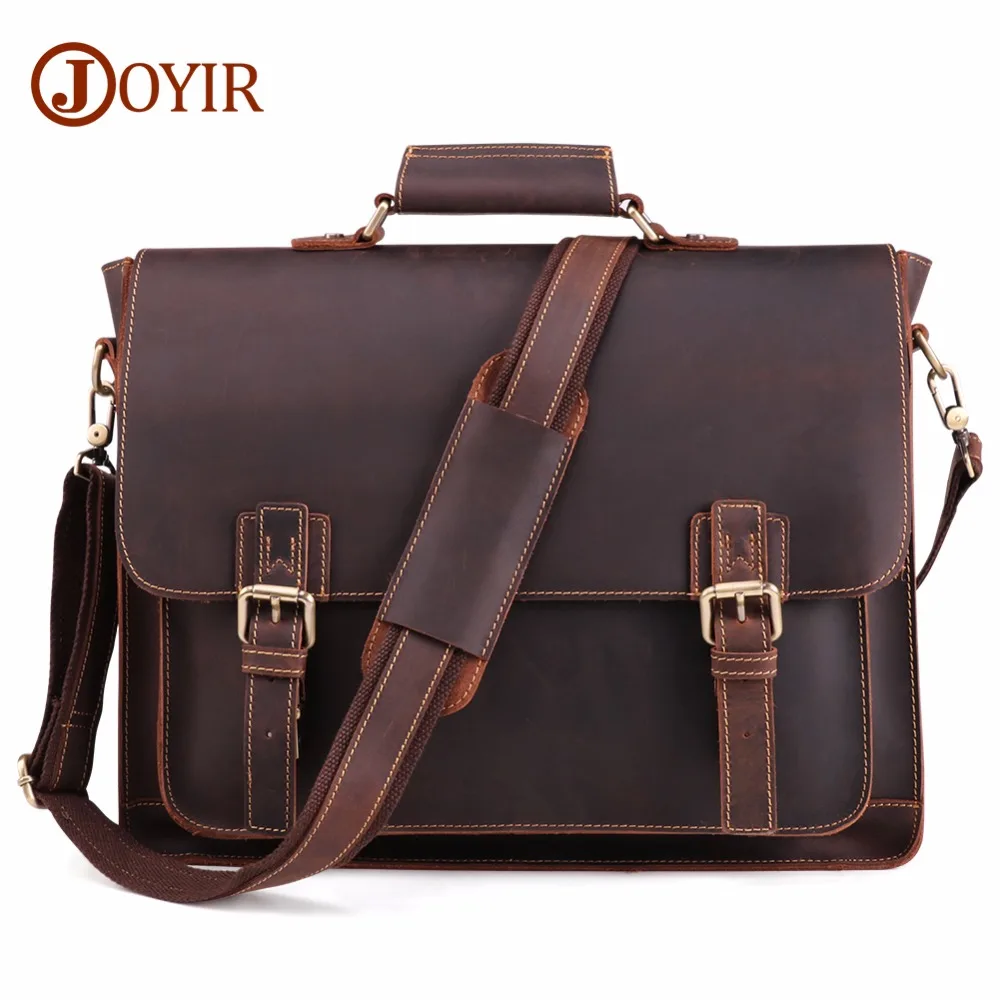
Quick Solutions for Common Messenger Bag Problems
Even the best messenger bags can present occasional challenges. Here are practical solutions for the most common issues:
Slipping Straps
– Immediate fix: Add a non-slip pad to the shoulder area of the strap
– Long-term solution: Replace the strap with a wider model with rubber backing
– Prevention: Select bags with textured underside straps or built-in non-slip features
Contents Shifting During Movement
– Immediate fix: Use small packing cubes or pouches to group similar items
– Long-term solution: Add aftermarket dividers or consider a bag with better internal structure
– Prevention: Choose bags with structured compartments and sufficient dividers
Weather Protection
– Immediate fix: Keep a compact rain cover in an external pocket for unexpected showers
– Long-term solution: Apply appropriate waterproofing treatment for your bag’s material
– Prevention: Select naturally water-resistant materials or designs with protective flaps
Weight Management
– Immediate fix: Conduct a daily edit of contents before leaving home
– Long-term solution: Transition to lighter versions of essential items (compact laptop vs. full-size)
– Prevention: Choose a bag with an ergonomic design and proper weight distribution
Organizational Chaos
– Immediate fix: Use color-coded pouches for different categories of items
– Long-term solution: Implement the zone system described earlier in this guide
– Prevention: Select a bag with sufficient organizational features for your specific needs
For commuters who sometimes need additional capacity, leather commuter totes offer an excellent companion to messenger bags for days requiring extra carrying capacity.
With proper selection, organization, and care, a quality messenger bag becomes more than just a way to carry your essentials—it becomes a trusted companion that enhances your daily routine through both function and style. The perfect messenger bag adapts to your changing needs while maintaining its fundamental benefits of accessibility, organization, and professional appearance.

